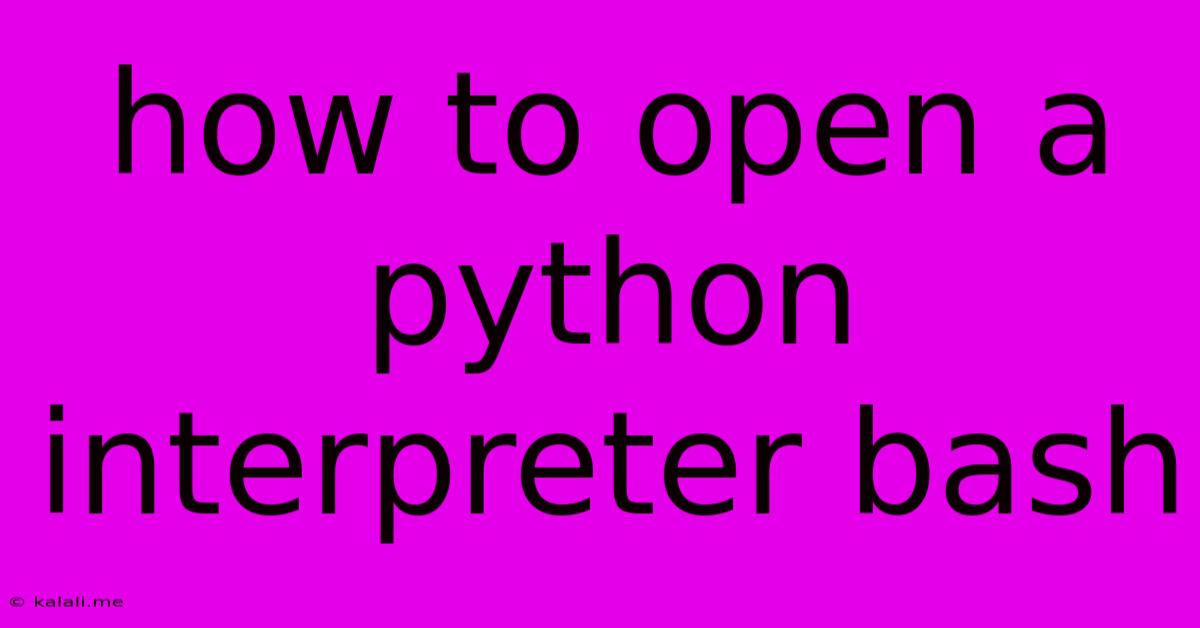How To Open A Python Interpreter Bash
Kalali
Jun 04, 2025 · 3 min read

Table of Contents
How to Open a Python Interpreter in Bash: A Comprehensive Guide
Opening a Python interpreter within your Bash shell is a fundamental step for any Python programmer. This guide will walk you through several methods, covering different scenarios and addressing common issues you might encounter. Whether you're a beginner just starting your coding journey or a seasoned developer needing a quick refresher, this tutorial has you covered. We'll explore the various ways to access the Python interpreter, focusing on efficiency and best practices.
Understanding the Python Interpreter
Before diving into the methods, let's clarify what the Python interpreter is. It's a program that reads and executes Python code line by line. It's your interactive coding environment, allowing you to test snippets, experiment with functions, and explore the language's features in real-time. This is different from running a Python script, which executes a complete program from a file.
Methods to Open a Python Interpreter in Bash
There are several ways to launch the Python interpreter from your Bash shell, depending on your system configuration and preferred approach.
Method 1: The python Command
The most straightforward method is using the python command directly in your Bash terminal. Simply type python and press Enter. This will launch the default Python interpreter installed on your system.
python
You'll see the Python interpreter prompt (>>>), indicating you're ready to start typing and executing Python code. To exit the interpreter, type exit() and press Enter.
Method 2: Specifying the Python Version (python3, python2, etc.)
If you have multiple Python versions installed (e.g., Python 2 and Python 3), you need to specify which version you want to use. Use python3 for Python 3 and python2 for Python 2 (if available).
python3 # For Python 3
python2 # For Python 2 (if installed)
Method 3: Using the python Shebang in a Script
While not directly opening an interpreter in the Bash shell, you can execute a Python script which implicitly uses a Python interpreter. This is done via a shebang line at the top of your Python script:
#!/usr/bin/env python3
print("Hello from a Python script!")
Make the script executable using chmod +x your_script.py and then run it directly from the Bash shell using ./your_script.py. This method is ideal for running complete programs.
Method 4: Using a Virtual Environment (Recommended)
For larger projects, it's highly recommended to use a virtual environment. This isolates your project's dependencies, preventing conflicts with other projects. After activating your virtual environment (e.g., using source myenv/bin/activate), you can then use the python command as described in Method 1. This ensures you're working with the correct Python version and dependencies for that specific project.
Troubleshooting Common Issues
command not found: This error means Python is not in your system's PATH. You may need to install Python or adjust your PATH environment variable.- Multiple Python Versions: If you have both Python 2 and Python 3, be sure to use the correct command (
python3orpython2). - Virtual Environment Issues: Ensure your virtual environment is activated before running the
pythoncommand within that environment.
Conclusion
Launching a Python interpreter from your Bash shell is a vital skill for any Python programmer. By understanding the various methods and addressing potential issues, you'll be well-equipped to efficiently interact with the Python interpreter and leverage its power for interactive coding and script execution. Remember that using virtual environments significantly improves project organization and dependency management.
Latest Posts
Latest Posts
-
Best Spring Break Locations In Us
Jun 05, 2025
-
When To Use Bell Trap Floor Drain
Jun 05, 2025
-
3 Way Motion Detector Light Switch
Jun 05, 2025
-
Clean Animals And Unclean Animals In The Bible
Jun 05, 2025
-
Gas Cap And Check Engine Light
Jun 05, 2025
Related Post
Thank you for visiting our website which covers about How To Open A Python Interpreter Bash . We hope the information provided has been useful to you. Feel free to contact us if you have any questions or need further assistance. See you next time and don't miss to bookmark.